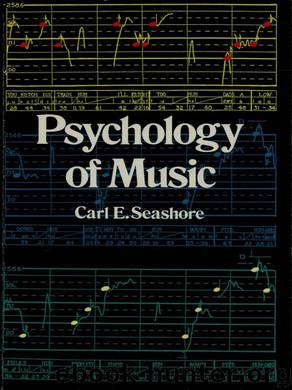Psychology of Music by Carl E. Seashore

Author:Carl E. Seashore
Language: eng
Format: epub
ISBN: 9780486121833
Publisher: Dover Publications
Published: 2012-10-12T16:00:00+00:00
FIG. 14.—Phrasing score for pitch renditions of the passage in Fig. 13 by four players. (Greene.38)
Figure 14 shows how the first four players performed that section of the Kreutzer Etude which lies between the two arrows in Fig. 13. The zero line denotes the pitch as established for the whole selection. The solid jagged line indicates deviations from this “true” pitch in the tempered scale, and the dotted jagged line shows the same for the natural scale or just intonation.
It is evident from these pictures that none of the players performed consistently in either of the two scales, although on the average their performance deviated from the tempered scale slightly less than from the natural scale. These situations are typical of all the performances studied, and of artistic performance in general.
We may now examine in Fig. 15 the composite findings for the six players of the five intervals intensively studied; namely, the minor second and major second, the minor third and major third, and the perfect fourth.
Minor second. The composite graph shows that there is a strong tendency to contract the minor second. The group as a whole contracted the minor seconds 0.06 of a tone below the tempered and 0.12 below the natural scale.
Major second. Reading the composite graph for the major second in the same manner as for the minor interval, we see that the major second is on the whole augmented. There are two values for the natural scale indicated, the larger at +0.02 and the smaller at—0.09 of a tone. The composite graph shows that the major second is augmented about 0.03 of a tone above the tempered scale, 0.01 above the larger natural scale interval value, and 0.12 above the smaller natural interval value. The smaller natural intervals are enlarged 98 per cent of the time, and the smaller 65 per cent.
Minor thirds. For the minor thirds the composite figure shows the arrow at—2, indicating that the average tendency of the group was to play 0.02 of a tone below the tempered scale, which makes it 0.1 of a tone below the natural scale.
Major thirds. For the major third the natural scale is 0.07 of a tone less than in the tempered. The average extent of its interval, as played, however, is 0.03 of a tone greater than its value in the tempered scale. This general tendency holds for all of the four players.
Download
This site does not store any files on its server. We only index and link to content provided by other sites. Please contact the content providers to delete copyright contents if any and email us, we'll remove relevant links or contents immediately.
Rewire Your Anxious Brain by Catherine M. Pittman(18554)
Talking to Strangers by Malcolm Gladwell(13232)
The Art of Thinking Clearly by Rolf Dobelli(10231)
Mindhunter: Inside the FBI's Elite Serial Crime Unit by John E. Douglas & Mark Olshaker(9206)
Becoming Supernatural by Dr. Joe Dispenza(8127)
Change Your Questions, Change Your Life by Marilee Adams(7638)
Nudge - Improving Decisions about Health, Wealth, and Happiness by Thaler Sunstein(7622)
The Road Less Traveled by M. Scott Peck(7524)
The Lost Art of Listening by Michael P. Nichols(7411)
Enlightenment Now: The Case for Reason, Science, Humanism, and Progress by Steven Pinker(7240)
Mastermind: How to Think Like Sherlock Holmes by Maria Konnikova(7231)
Win Bigly by Scott Adams(7097)
The Way of Zen by Alan W. Watts(6509)
Daring Greatly by Brene Brown(6449)
Big Magic: Creative Living Beyond Fear by Elizabeth Gilbert(5616)
Grit by Angela Duckworth(5525)
Ego Is the Enemy by Ryan Holiday(5297)
Men In Love by Nancy Friday(5162)
Altered Sensations by David Pantalony(5048)
